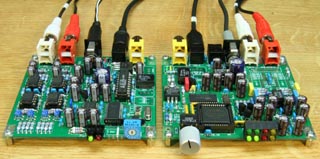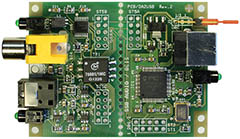Audio ADC and DAC kits - AD24QS, DA24QS and DA24DS
( Deutsche Version: Audio ADC und DAC Bausätze - AD24QS, DA24QS und DA24DS)
Deutsche Version: Audio ADC und DAC Bausätze - AD24QS, DA24QS und DA24DS)
AD24QS - Audio Analog to Digital Converter 24 Bit / 192 kHz (4th Generation)
AD-IOA - Microphone Preamplifier and more for the ADC
New and quite unique: DA2USB - Digital Audio to USB Interface
DA24QS - Audio
Digital to Analog Converter 24 Bit / 192 kHz (3rd Generation)
DA-IOP - Module for the
DA24QS-B with Connectors for Balanced In- and Outputs ("Passive")
DA24DS - Audio Digital to Analog Converter 24 Bit / 96 kHz (Available again!)
 Here I introduce my Analog to Digital
Converter AD24QS, the Digital to Analog Converter DA24QS ("QS"
stands for "Quad Speed") and my DA2USB Digital Audio to USB Interface. The designs went through quite a couple of redesigns
and I believe them to be really fine.
Here I introduce my Analog to Digital
Converter AD24QS, the Digital to Analog Converter DA24QS ("QS"
stands for "Quad Speed") and my DA2USB Digital Audio to USB Interface. The designs went through quite a couple of redesigns
and I believe them to be really fine.
With a design like this, it cannot be and it never was my intention
to beat the price of cheap devices commercially available. I can
beat the quality only. If you need something cheap I can probably
give you tips, too.
Click here
(or on the photo) for an enlarged view of both devices. (On
the left is the AD24QS, on the right the DA24QS.)
The new DA2USB is a driverless USB interface for transferring digital audio signals into a PC with up to 192 kHz / 24 bit. Thus it is a perfect completion for my ADCs. I designed it (admittedly by far not alone), because I often was asked for something like this and I didn't know any comparable solution.
Quick links to the articles, chapters and the most important
design files:
Project "AD24QS
- Audio Analog to Digital Converter 24 Bit / 192 kHz" unfortunately sold out, Successor planned
and "AD-IOA
- Balanced In- and Outputs and Microphone Preamplifier":
General Description
Circuit Description
The DIY Section
Circuit diagram AD24QS as GIF-file or PDF-file
Circuit diagram AD-IOA as GIF-file or PDF-file
Assembly drawing AD24QS-K indicating the component names and the component types or values
Assembly drawing AD-IOA indicating the component names and the component types or values
AD24QS Bill of
Material
AD-IOA Bill of
Material
How to order
 Project "DA2USB - Digital Audio to USB Interface"
Project "DA2USB - Digital Audio to USB Interface"
General Description
Specifications
USB Audio Classes
Operation
The DIY Section
Getting Started with Audacity
How to order
Projects "DA24QS
- Audio Digital to Analog Converter 24 Bit / 192 kHz" Successor planned
and "DA24DS - Audio Digital to
Analog Converter 24 Bit / 96 kHz":
General Description
Circuit Description
The DIY Section
Circuit diagram DA24QS as GIF-file
or PDF-file
Circuit diagram DA24DS as GIF-file
or PDF-file
Assembly drawing, standard kit version DA24QS-K without balanced
outputs, indicating the component
names and the component
types or values
Assembly drawing, version DA24QS-B with balanced outputs,
indicating the component names
and the component types or values
Assembly drawing, DA24DS-K, indicating the component
names and the component
types or values
Bill of Material
How to order
How do they sound?
Every now and then I am asked about the sound of the converters
or if I compared them to other devices by listening. My opinion
concerning the quality of (not only my) converters is a very technical
one and I must be a little careful because occasionally I might
cause objections:
It is very well known what kind of deviations from the original
signal a human ear is able to hear (e.g. distortion, frequency
response, noise etc.) and also in which amount and under which
circumstances this is the case. All these deviations from the
original signal are measurable with a precision and sensitivity
far, far superior to the human ear. I believe that any electronic
system that is able to process audio signals in a way that they
are falsified far less than what a human ear is able to recognize
has no "sound", i.e., it can not be distinguished from
other systems with a comparable quality. Given that, any audible
difference is either imagination(!) or a deliberate or unintentional
deviation from neutrality by design (and thus again measurable). This is
why I do not believe in simple sound comparisons. Microphones
and loudspeakers cannot and tube-amps shall not be neutral, for
instance.
My conviction in other words: Would I hear the difference
between a naked piece of wire and my converters I'd bet, there
is something wrong with them. Or with the wire.
When trying to compare mine to other converters please also
keep in mind: As far as I know, there are quite few pure analog
/ S/P-DIF converters like mine available in the world. Most equipment
is PC-based, and to compare equipment designed for such different
conditions of service would not be realistic - would it?
Some Unnecessary Words about the History (and Me)
The original intention for these designs had been my pure interest
of designing such a pair of converters for myself. I aimed a very
good technical quality, a couple of particular properties and
it should look nice. When the first ADC design, the AD2496,
finally satisfied me (after two redesigns), I decided to let other
people know what I did and wrote about it on my website (the very first article).
The DAC, by the way, did not work as good as I aimed and it
wasn't as elegant either. Any improvement wouldn't do. A completely
new concept was required instead, but I had none. Thus I ceased
this project.
However, I found it to be unsatisfactory that other DIYs weren't
able to reproduce the ADC because they would at least need the
PCB. So I started to offer and sell PCBs. Anyway - there were
still a couple of components more or less impossible for DIYs
to get. Even I had quite a lot of problems to get these odd parts
for my sample devices. E.g., many of them are simply not available
in small quantities.
Thanks to the people who bought the PCB anyway I saw there
was enough interest for kits and I began to provide complete kits.
Believe me, this is much more work than just to get hold
of the missing components for a single device. E.g., you cannot
buy exactly as much as you need - you have to buy packing units
and of course from these packing units there will be parts left
when the first parts that cannot be bought singly are sold out.
Other sorrow was caused by delivery times, allocation, erroneous
orders and so on. And, of course, the price for the DIYs should
be fair. No, that was not easy.
When the first lot of kits was sold out (to be more precise:
The first critical component was sold out), I originally didn't
want to continue the kits. But it seemed to become a sad time
without selling kits. Once again DIYs reading the article(s) and
not being able to build it? And I had ideas how to improve the
design, I had a couple of components left over... So I did not
only start the redesign of the ADC but also the DAC, because I
had a new concept. And I ordered components, once again. Because
I prepared the dual channel preamplifier as a kit as well, this
time I had to buy and stock 4 times as much components as before...
In May 2009 I started one more round of kits, upgraded by
the new DA24DS (meanwhile available on request only).
Up to now I made 7 revisions of the ADC-PCB (3 x AD2496, 4
x AD24QS), and another 3 revisions of the DAC-PCB (plus the ceased
version). Both designs went through quite a lot of improvements.
I am quite petty with details.
Anyhow, this project still remains a hobby for me. But
of course, I hope, it is going to become a huge success. *Sigh*...
| Last update: January 23rd, 2022 |
Questions? Suggestions? Email
Me! |
Uwe Beis |
![]() Deutsche Version: Audio ADC und DAC Bausätze - AD24QS, DA24QS und DA24DS)
Deutsche Version: Audio ADC und DAC Bausätze - AD24QS, DA24QS und DA24DS)

